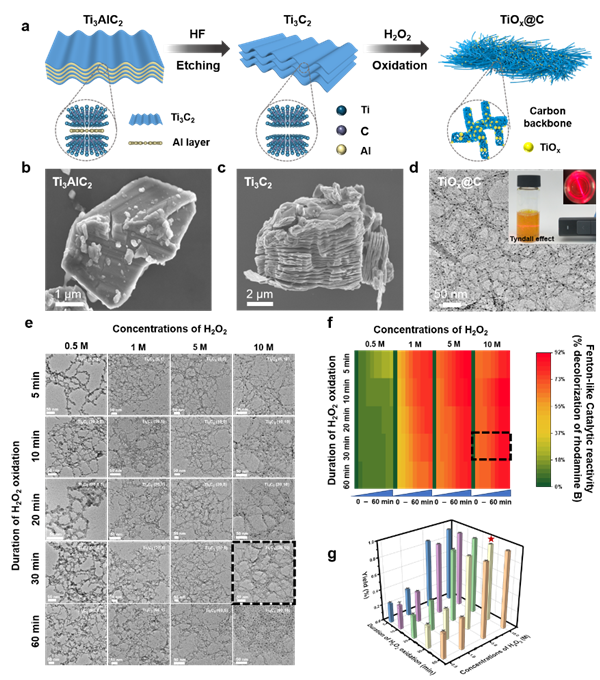Recently, the internationally authoritative journal Proceedings of the National Academy of Sciences of the United States of America (PNAS) published online the research paper "In situ turning defects of exfoliated Ti3C2 MXene into Fenton-like catalytic active sites" by Professor Lin Sijie of the School of Environmental Science and Engineering.

This study proposed a new strategy for the in-situ construction of Fenton-like nanocomposite catalysts by ingeniously utilizing MXene intrinsic surface defects and rich transition metal sources. In this paper, using Ti3C2 MXene as a template, a series of amorphous carbon-loaded high-density TiO1.47 nanoclusters have been prepared( TiO1.47@C )The reaction mechanism of activating H2O2 with Ti-based Fenton catalyst to degrade atrazine was revealed, and the realization path of two-dimensional nanomaterial "Safer-by-design" was demonstrated with examples, which provided a new strategy for the efficient treatment of endocrine disruptors and new antibiotic pollutants.

A new H2O2 wet oxidation process has been developed. Taking Ti3C2 MXene as a template, using the intrinsic Ti defects formed during the etching process to have a strong oxidation-reduction reaction with H2O2, the amorphous carbon-supported high-density TiO1.47 nanoclusters were formed in situ( TiO1.47@C )。 The optimum preparation conditions (10 mol · L − 1 H2O2, 30 min) were selected by changing the concentration and action time of H2O2, and the maximum sample yield (>97%) was achieved at the same time. It is further proved by DFT theoretical calculation that the Ti defect on the surface of Ti3C2 MXene is the key reactive active site for the formation of TiO1.47 nanoclusters. The nanoclusters have rich surface defects and the coexistence of Ti multi-valence states exists in the system (the average valence state is+2.94). Based on the analysis of bond formation changes by X-ray absorption fine structure spectroscopy (EXAFS), it is concluded that the fracture of Ti-C-Ti bond and the formation of Ti-O bond caused by the in-situ oxidation of H2O2 during the synthesis process are the key to the in-situ synthesis of the nanoclusters. The efficient activation of H2O2 through the valence change of Ti element has achieved the efficient degradation of many typical new pollutants (such as atrazine, tetracycline, p-nitrophenol, etc.).

This method has good universality and is applicable to a variety of MXene family materials, including V2C, Nb2C, etc. This research broadens the environmental application potential of MXene family materials, realizes the composite anchoring of nanoclusters on the carbon substrate while catalyzing the in-situ synthesis of nanoclusters with high activity, and effectively reduces the potential environmental risks caused by material leakage during the use process.
Professor Lin Sijie is the only corresponding author of the paper, and Jiang Yue (now a postdoctoral fellow), a direct doctoral fellow of the School of Environmental Science and Engineering, is the only first author. The work has also been carried out by the team of Professor Liang Shixian of Hong Kong Baptist University, the team of Associate Researcher Wang Liming of the Institute of High Energy Physics of the Chinese Academy of Sciences, and the team of Professor Sheng Wenchao of Tongji University Strong support from Dr. Jinshan, Suzhou Institute of Nanotechnology and Nanobionics, Chinese Academy of Sciences, and the BL14W1 line station of Shanghai Synchrotron Radiation Light Source. The research was supported by the National Natural Science Foundation of China, the National Key Research and Development Plan and the special funds for basic scientific research business expenses of central universities.
Technological innovation
Honesty is the foundation
Contact Number: +86-15698999555 |
Address: NO.6 ,SHENGHUA STREET,TAIHE DISTRICT, JINZHOU CITY, LIAONING PROVINCE, CHINA. |